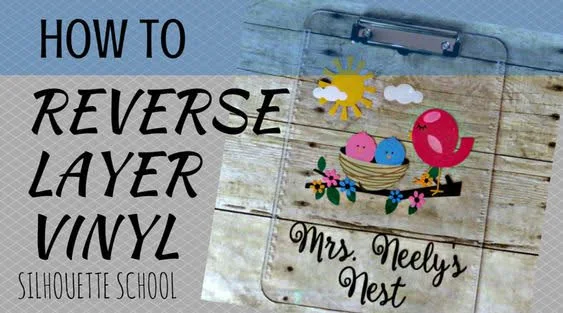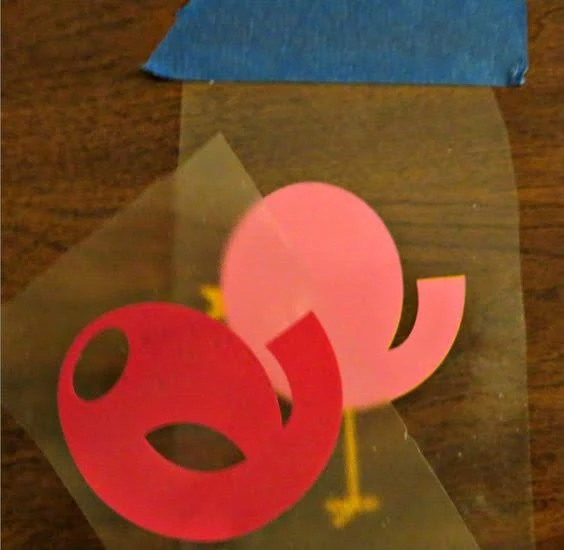Silhouette School weekly contributors Becky and Glenna from My Paper Craze are here to explain this technique.
I started with drawing a box the
size of the clipboard in my design space, and I added a black rectangle
to show where the clip is attached to the board, since that needs to be
considered when designing.
Next, I played with and designed the layout until I was happy with the total look. The design I put together was an easy decision since it matches this teacher's classroom theme. I found a couple of designs in the Silhouette Store that I combined to get the look I was going for.
One thing to remember when cutting a reverse layering design, is to MIRROR (or horizontally flip) the image. You'll be applying it to the reverse side of a clear object, so you will be looking at the back of the design. It'll take a few minutes to wrap your mind around that, but that's okay. It took us several tries to get the hang of this.
Just a tip: when cutting multiple colors, I find that it's helpful to go ahead and separate all your color layers before you start cutting. This helps to make sure that when it's time to cut, you don't have to worry about having all your pieces together.
Once all your individual pieces are cut, go ahead and weed like normal and transfer onto your clear transfer sheet. You'll need a relatively clean and clear area, depending on your design. As you can see, we had a lot of small pieces, so we spread them out, upside down on the transfer paper, ready to be layered.
Now here's the tricky part. You have to layer this whole design from front to back. Why? Because if you start with the front and stick it to your clear surface, you won't know where to position your next piece. Take this bird for example, the first piece would be the black vinyl for the eye. Since it's smaller, the next piece (hot pink) would eclipse the black and it all turns into a guessing game. You want to layer all your pieces together on the transfer tape, instead of your project, so that you can continually see the layering pieces. Let's see it in action.
First, we started with the yellow, adhesive side up. Yes, leave the yellow on the adhesive transfer sheet, laying with the adhesive side facing you. As you can see, I put some painters tape on the top and bottom to help hold it in place. You kind of have to create your own little mantra "adhesive side up, adhesive side up, adhesive side up". Our minds are so trained to stick the adhesive side down, you'll need the reminders throughout the layering project (or at least I did!).
Now it's time to layer the light pink. With the adhesive side up, apply another layer of (clean) transfer tape. You end up with a vinyl sandwich. You'll then peel off the first piece of transfer tape (on the glossy side of the vinyl). With the glossy side exposed, line it up with the yellow piece (remember, the yellow has the adhesive exposed). This way, the yellow adhesive sticks to the pink glossy side. You then remove the transfer tape on the light pink, exposing the adhesive on the pink and some parts of the yellow. Are you following along?
Now, do the same with the hot pink (and any subsequent layers. Make your vinyl sandwich with the hot pink and the transfer tape. Peel off the transfer tape on the glossy side of the hot pink and line it up with the light pink. The light pink will stick to the glossy hot pink. Remove the remaining transfer tape on top of the hot pink. Repeat with the small black eye vinyl piece.
Once you've layered all your pieces, you will have a finished product, still adhesive side up. This is important because this is what you will stick to the back of the clipboard (or whatever project you are working on). Depending on the design, this can be a tedious process. We recommend starting with a simple project.
Once all your vinyl pieces are reverse layered, it's time to assemble them on a piece of transfer tape large enough to hold the entire design (again adhesive side up).
Once my design was complete AND fully assembled on the transfer sheet adhesive side up, looking through the clear clipboard, I lined up the design and laid the clipboard on top of the design. Once it was reasonably stuck, I turned the clipboard over and burnished the vinyl. Finally, remove your transfer sheet and your project is done. I know it seems like a lot of work, but once you get the hang of reverse layering, it's a really neat addition to your Silhouette skills.
Note: This post may contain affiliate links. By clicking on them and purchasing products through my links, I receive a small commission. That's what helps fund Silhouette School so I can keep buying new Silhouette-related products to show you how to get the most out of your machine!
Thanks for coming to class today at Silhouette School. If you like what you see, I'd love for you to pin it!

Get Silhouette School lessons delivered to your email inbox! Select Once Daily or Weekly.



















.png)




The technique will also work for reverse layering vinyl onto the glass of a picture frame. I wish I had read your article before my wife and I fumbled through our attempts.
ReplyDeleteThank you!
There's an even easier way. Print a copy of your design. Put it under the clip on the board. Flip the clipboard over. Starting with the color that will be on the "top" when viewing from the right side, use the print out to lay your first layer.. Then lay the next, and so on. So easy!
ReplyDeletethanks for that idea!
DeleteCould we get a video tutorial on this?
ReplyDeleteDo you know if there is a maximum number of layers that will still allow the decals to be sturdy? Like for example, the red and pink bird, you overlapped the red over the pink decal. If there are more than 2 colors, would it still make sense to add another later or you may have to cut out the details instead and just align them accordingly such that it will be the least number of layers at any part of the design?
ReplyDelete